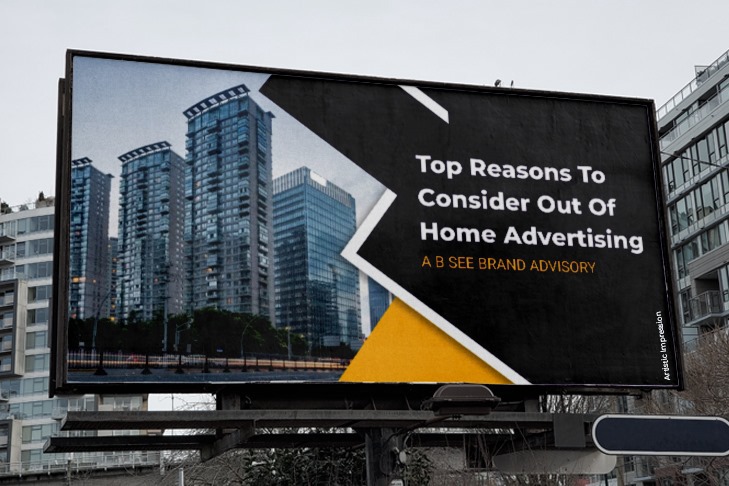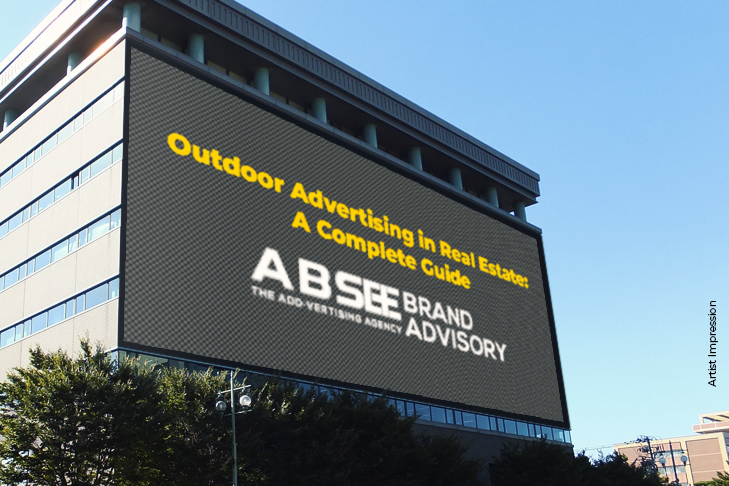What is the difference between indoor and outdoor advertising?
In the bustling world of marketing and promotion, two prominent avenues stand out for businesses seeking to capture the attention of their target audience: indoor and outdoor advertising. Both approaches hold distinct advantages and cater to diverse marketing goals.
In this comprehensive blog, we will delve into the definitions of indoor and outdoor advertising, explore the benefits they offer, dissect their types, discuss key differences, and offer valuable tips for successful implementation. Whether you’re an Ad Agency in Mumbai, a branding agency, or simply an enterprise looking to make a mark, understanding indoor and outdoor advertising strategies is essential.
What is the Definition of Indoor Advertising?
Indoor advertising is a type of advertising that is displayed in enclosed spaces, such as buildings, transportation hubs, and retail stores. Indoor advertising media refers to the various types of media that can be used for indoor advertising, such as digital screens, posters, and flyers. Indoor advertising campaigns are the strategies and tactics used to deliver indoor advertising messages to target audiences.
Real estate advertising in Mumbai has evolved into a dynamic and multifaceted landscape, encompassing both indoor and outdoor strategies. In the heart of this bustling metropolis, indoor advertising plays a crucial role, leveraging platforms such as digital screens in malls, interactive kiosks, and real estate expos.

What is meant by Indoor Advertising?
Indoor advertising encompasses promotional efforts directed at captivating audiences within confined or enclosed spaces. This form of advertising strategically positions content where potential customers are more likely to interact with it while indoors. As businesses vie for consumer attention, indoor advertising seizes the opportunity to captivate them during various moments, such as shopping, waiting, or working indoors.
Indoor advertising is a type of advertising that takes place in enclosed spaces, such as:
- Shopping malls
- Airports
- Train stations
- Office buildings
- Hospitals
- Hotels
- Restaurants
- Gyms
- Schools
- Universities
- Other public spaces
Indoor advertising can be used to reach a captive audience of people who are already in a buying mindset. When Indoor ads are managed by the best advertising agency in Mumbai, It can be a cost-effective way to reach a large number of people in a short amount of time.
What Are The Benefits Of Indoor Advertising?
Strong Retention Levels
Indoor advertising benefits from the relatively captive nature of indoor spaces. People tend to spend considerable time indoors, and as a result, their exposure to indoor advertisements is often more prolonged, leading to higher message retention.
Unlimited Creativity Options
The indoor environment offers a controlled setting that allows advertisers to employ a wide range of creative techniques. From interactive digital displays to immersive in-store experiences, the possibilities are limitless.
Incredibly Cost-Effective
Indoor advertising can be highly cost-effective, especially when compared to some outdoor advertising methods. It allows businesses to target specific demographics with precision, ensuring that resources are utilised efficiently.
Types of Indoor Advertising
Point of Sale Advertising
This involves placing advertisements at the point of purchase, encouraging impulse buying and providing last-minute information to customers.
Digital Signage
Digital screens placed in indoor spaces such as shopping malls, airports, and waiting areas display dynamic content that engages audiences.
Indoor Billboards
Similar to their outdoor counterparts, indoor billboards are placed in high-traffic areas within enclosed spaces, capturing the attention of visitors.
In-Store Media
Advertisements within retail stores, including shelf displays, banners, and interactive kiosks, engage shoppers during their purchase journey.
What is Outdoor Advertising?
Outdoor advertising involves promoting products, services, or brands through advertisements placed in various outdoor locations. Outdoor advertising takes on a vibrant dimension in Real Estate Advertising in the Mumbai market, contributing significantly to its visual and informational outreach. These ads can range from massive billboards along highways to transit advertisements on buses, trams, and trains, as well as ads on street furniture and unconventional outdoor spaces.
Types of Outdoor Advertising
Hoardings
Hoardings, also known as billboards, are larger-than-life displays that often dominate highways, streets, and high-traffic areas. Their size and strategic placement ensure maximum visibility.
Transit Advertising
This type of outdoor advertising capitalises on the constant movement of people using public transportation. Advertisements are placed on buses, trains, trams, and other forms of public transit.
Street Furniture Advertising
Street furniture such as bus shelters, kiosks, benches, and even trash cans can be transformed into advertising mediums, reaching pedestrians and commuters.
Non-Traditional Outdoor Advertising
This includes unconventional methods like aerial advertising, guerrilla marketing, and 3D installations that catch people’s attention in unexpected ways.
A B SEE Brand Advisory excels in both indoor and outdoor advertising, positioning itself as one of the premier Ad Agencies in Mumbai.
How to do Indoor and Outdoor Advertising?
Outdoor Advertising:
- Identify high-traffic areas where your target audience is likely to pass by.
- Choose the appropriate type of outdoor advertising, considering factors like visibility, budget, and message delivery.
- Design eye-catching visuals and concise messages that can be quickly understood by the passersby.
- Collaborate with outdoor advertising agencies to secure prime locations and negotiate contracts.
Indoor Advertising:
- Understand the layout and flow of indoor spaces to position advertisements strategically.
- Use digital signage and interactive elements to create engaging experiences.
- Tailor content to match the context of the indoor environment and the interests of the audience.
- Collaborate with venue owners or managers to secure display spaces and ensure compliance with regulations.
Key Difference between Indoor and Outdoor Advertising
Differences in Goals
Indoor advertising tends to focus on engaging a captive audience and fostering brand loyalty through extended exposure, while outdoor advertising aims for broad visibility and quick message delivery to passersby.
User-Friendly Software
Indoor advertising often leverages digital technology, enabling real-time updates and dynamic content display, while outdoor advertising software might focus more on static visuals.
The Target Audience
Indoor advertising appeals to people spending time in specific venues, such as shopping malls or waiting rooms, while outdoor advertising reaches a diverse range of people in public spaces.
Accessibility
Indoor advertisements are seen by people who intentionally enter a specific location, while outdoor advertisements target individuals in transit or moving around outdoors.
The synergy between indoor and outdoor real estate advertising in Mumbai forms a cohesive strategy that caters to diverse audiences.
Tips for Successful Outdoor Advertising
Careful Planning and Precision
Choose locations strategically based on target demographics and foot traffic data.
Make Your Outdoor Tactics Shareable
Craft advertisements that are visually appealing and shareable on social media platforms.
Don’t Waste Money on low-traffic locations
Prioritise high-traffic areas to maximise the reach of your outdoor advertisements.
Less is more
Keep your message concise and easily digestible, as outdoor ads have limited time to capture attention.
A branding agency in Mumbai can help you create a strong brand identity for your business. They can use indoor and outdoor advertising to reach your target audience and build brand awareness.
Indoor and Outdoor Advertising: Which one should you Opt For?
The decision between indoor and outdoor advertising depends on your marketing goals and target audience. Outdoor advertising is suitable for creating widespread brand awareness, while indoor advertising can foster deeper engagement and connection with potential customers. It’s often beneficial to incorporate a mix of both strategies for a well-rounded marketing approach.
Top Indoor and Outdoor Advertising Agency
ABSEE: ABSEE is a full-service that offers a wide range of services, including outdoor advertising, indoor advertising, print advertising, digital advertising, and more. They have a team of experienced professionals who can help you create and execute a successful advertising campaign. They are one of the best advertising agencies in Mumbai.
When choosing an agency, it is important to consider your budget, your target audience, and your specific needs.
A good branding agency in Mumbai will be able to help you choose the right mix of indoor and outdoor advertising to reach your target audience and achieve your branding goals.
FAQs Related to Indoor and Outdoor Advertising
1. What are indoor and outdoor advertisements?
Indoor advertising is any type of advertising that is displayed inside a building or enclosed space, such as malls, airports, cinemas, and public transport vehicles. Outdoor advertising is any type of advertising that is displayed outside, in open spaces like billboards, bus shelters, and on vehicles.
2. Which is a form of indoor advertising?
Here are some of the most common forms of indoor advertising:
- Promotional posters.
- Flyers.
- Decoration of shop windows
- Floor graphics.
- Promotional stands.
- Information tables.
- Lightboxes.
- Leader boards.
The best type of advertising for your business will depend on your target audience, budget, and branding goals. A branding agency in Mumbai can help you assess your needs and develop a custom advertising plan that will help you achieve your branding goals.
3. What is indoor media?
Indoor media refers to the various channels that are used to deliver indoor advertising messages. These channels can include:
- Print: This includes posters, flyers, brochures, and other printed materials.
- Digital: This includes digital displays, such as LED screens and interactive kiosks.
- Audio: This includes radio ads and other audio messages that are played in enclosed spaces.
- Visual: This includes light boxes, floor graphics, and other visual displays.
- Tactile: This includes promotional stands and other interactive displays that allow people to touch and feel the products or services being advertised.
4. What is indoor advertising called?
Indoor advertising is also known as ambient advertising or in-store advertising. Indoor ad agencies in Mumbai help businesses reach their target audience in enclosed spaces such as malls, airports, and train stations.
5. What is an example of outdoor advertising?
Here are some examples of outdoor advertising:
- Billboards
- Bus shelters
- Train station posters
- Lightboxes
- Vehicle wraps
- Aerial advertising
- Guerrilla marketing
Outdoor ad agencies in Mumbai help businesses reach their target audience in open-air settings, such as billboards, bus shelters, and taxis.









Leave a Reply